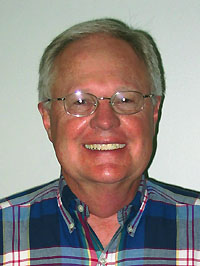 |
||||||||
PROFILE: Bay Statesman Announces
Retirement, Plots New Adventures
 Dick Eckenrod |
Arriving in Florida in 1968 with a newly minted degree in mechanical engineering from the University of Texas, Dick Eckenrod’s first job in Tampa Bay was at Westinghouse’s now-defunct nuclear facility just south of the Gandy Bridge.
While designing components used in nuclear plants around the world, Eckenrod was entranced by the coastal ecosystems at the waterfront campus. “It was totally unlike anything I’d ever seen in Texas and I just fell in love,” he recalls. “I started taking courses in biology and life sciences at local junior colleges to get some background, then went back to school at Louisiana State University to get an MS in marine science.”
Nearly 40 years later, he’ll get a chance to spend more time on the bay he loves. Eckenrod is retiring as executive director of the Tampa Bay Estuary Program, a post he’s held since 1990 when the first President Bush designated Tampa Bay as an “estuary of national significance.”
He leaves with the bay in its best shape in recent memory – meeting water clarity goals in all segments for the first time since 1975 – but still facing a myriad of challenges as the region’s population continues to grow.
Stormwater Critical Concern
The bay’s remarkable turnaround, from an estuary overwhelmed with practically untreated sewage to a sparkling gem that has made Tampa Bay the envy of the nation, actually began before Eckenrod came on board with the 1972 Wilson-Grizzle Bill that mandated advanced wastewater treatment for sewage plants discharging into the bay.
With wastewater under control, it was clear that stormwater was going to be the biggest issue for the future. “We knew we had to ‘hold the line’ on nitrogen loadings so there was no net increase even as the region grew.”
The public-private Nitrogen Management Consortium, established by the TBEP and composed of both local governments and key water-dependent industries, has achieved ambitious goals, maintaining nitrogen emissions at 1992 levels by offsetting anticipated increases of 17 tons per year. Meeting that goal, however, is harder every year. “I’d always been concerned that the line would slip someday,” he says.
New regulations now being considered by the state Department of Environmental Protection are likely to make it possible to continue to hold nutrients at levels where the bay can continue to thrive, he said. “It looks like they’ll require that post-development nutrient loadings do not exceed pre-development loadings.”
And those pre-development loadings, he adds, may actually be based on historic rather than current uses, so that loadings from citrus groves being transformed into neighborhoods might be tracked back to the original scrubland or forest. “It would be hard to overstate the importance of this regulation,” he says.
It’s not as simple as a retention pond at the end of every street, but it can be done with a “treatment train” that captures stormwater as close to the source as possible with low-impact development, he says. Current regulations require that 40% of post-development nitrogen is removed from stormwater but even that less-than-lofty goal isn’t always accomplished.
| “We knew we had to ‘hold the line’ on nitrogen holdings so there was no net increase even as the region grew.” |
Atmospheric Deposition Raises New Questions
Along with stormwater, nitrogen carried in air pollution, or atmospheric deposition, poses major challenges for Tampa Bay, said Eckenrod. “We hadn’t identified atmospheric dedeposition as a major source of nitrogen in the beginning, but it’s probably responsible for nearly half of the loadings, if you count both direct deposition and deposition on land that ends up in the bay in stormwater.”
Stationary sources like power plants contribute more than half of the total nitrogen emissions in the Tampa Bay airshed, he said, but TECO and Florida Progress both have taken major steps to reduce emissions. “TECO took a giant step forward when it repowered the Gannon plant with natural gas, and now Florida Progress is doing the same thing with its Bartow plant on Weedon Island. I think we’ll start seeing a difference soon.”
Seagrasses Rebound but Questions Remain
Two hallmarks of the estuary program – and the organizations that preceded it – are their science-based focus and their emphasis on very specific, achievable and measurable goals. TBEP’s first management plan, released in 1996, called for a seagrass recovery goal of approximately 12,000 acres, while preserving the bay’s existing 26,000 acres, for a total of 38,000 acres baywide.
Across the bay, seagrasses have rebounded, with aerial mapping last year estimating coverage of about 28,299 acres, less than TBEP’s goal of 38,000 acres but the highest recorded total since the 1950s.
But with water clarity at its highest level in 40 years, computer models predict that up to 12,000 more acres of seagrasses could be growing in Tampa Bay. No one is sure why they’re not growing but a series of research initiatives is underway. “I think what we’ll probably find is that seagrasses actually need much better water quality to start growing than to continue growing, but I doubt we’ll find a single ‘smoking gun’ that explains what’s happening,” he said.
| Eckenrod's retirement plans include a more active role in volunteer organizations like Tampa Bay Conservancy and surveying fish populations with a hook and line from his brand-new kayak. |
 |
Here “Since God Poured Tampa Bay”
Although it’s been said that Eckenrod has been working to make Tampa Bay better “since God first poured it,” he actually joined Save our Bays after the fledgling organization had graduated to meetings in the library rather than members’ homes. “People like Robin Lewis, Betty Castor and John Betz, a USF biologist, already had recognized the problems and were working to solve them,” he said.
Tampa Bay was his first choice to relocate when he graduated from LSU so he joined an environmental firm in Manatee County. “I really wasn’t cut out to be a consultant,” he says. “I loved the work but didn’t keep a good eye on the bottom line.”
He went to work for Manatee County government as its director of phosphate mining and led an initiative that resulted in the county buying 10,000 acres, now known as the Duette Preserve, in the Manatee River watershed to protect it from mining. “The referendum passed with 78% of voters supporting it, but it was a pretty easy decision because our water was at stake.”
Then, when the legislature created the Surface Water Management and Improvement (SWIM) program in 1987, Eckenrod leapt at the chance to work in an estuarine ecosystem with friends he’d made over the years. The volunteer-driven Save our Bays had evolved into the Agency on Bay Management, a bay-wide stakeholders committee of the Tampa Bay Regional Planning Council. As SWIM’s second employee, he helped craft a management plan that focused on habitat restoration and stormwater runoff. “The SWIM plan looked a lot like the previous plans, but this time we had money attached to it,” he says.
The creation of the Tampa Bay National Estuary Program in 1990 also came with cash but changed the way the bay was managed as well. Rather than “top-down” plans designed by experts to resolve the problems they had identified, the EPA required that NEP funds be used to create a “bottoms-up” plan that involved stakeholders at all levels. “They gave us five years and a million dollars a year – including research, of course – to develop the plan.”
As pleased as he is with the bay’s recovery, Eckenrod believes his real legacy to TBEP is building the consensus that brought multiple governments and private entities together working toward science-based goals that benefit the bay. The interlocal agreement fashioned by the nitrogen consortium, for instance, was the first of its kind. It still stands as a benchmark for other governments as increased state and federal standards for water quality are enacted.
“The agreement satisfies DEP with ‘reasonable assurance’ that water quality requirements for Tampa Bay can be met without the need to establish TMDLs (total maximum daily loads),” he notes. “It gives us more flexibility because we can work together to meet those goals.”
While Eckenrod will no longer run TBEP, he’ll stay involved in Tampa Bay’s restoration and protection. He’ll explore tidal creeks in a brand-new kayak, and conduct surveys of fish populations with a hook and line. Back ashore, he’ll restore coastal habitats surrounding his home on the Manatee River, chopping down and mulching the Brazilian peppers that have encroached, and he’ll take a more active role in non-profit organizations like the Tampa Bay Conservancy.
Just as his co-workers would have expected, Eckenrod did everything he could to make the transition as smooth as possible. He won’t step down until February leaving plenty of time for a national search for his replacement – but it still won’t be easy.
“He’s leaving us such a legacy,” says Heidi McCree, former chair of SWFWMD’s governing board. “He has this ability to achieve consensus that’s really an art. He’s made the estuary program a role model for the nation and we’ll be looking for someone who can emulate those skills and build on all he has done.”

